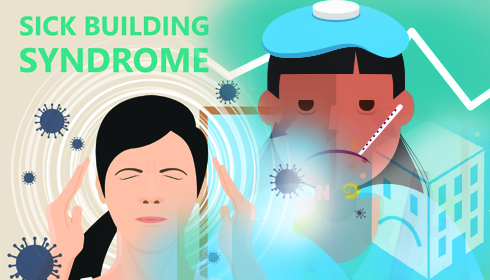
Sick Building Syndrome (SBS)
Sick Building Syndrome (SBS) refers to a condition where occupants of a building experience a range of health and comfort issues that are linked to the time spent in that specific environment. The term is used when the symptoms cannot be attributed to any specific illness or cause but are associated with the time spent in a particular building.
SBS can arise from various factors related to indoor air quality, ventilation, and other environmental conditions within a building. Common contributors include poor air circulation, inadequate temperature and humidity control, the presence of airborne pollutants, mould, inadequate lighting, and the off-gassing of volatile organic compounds (VOCs) from building materials and furnishings. Additionally, factors such as inadequate cleaning, pests, and even psychological factors can contribute to the development of SBS.
SBS typically develops when occupants are exposed to the aforementioned environmental factors over an extended period of time. Poor indoor air quality, for example, can result from insufficient ventilation or the presence of pollutants, leading to a buildup of contaminants. The cumulative effect of these factors can trigger a range of symptoms in individuals working or residing in the affected building.
In a study examining the correlation between commercial buildings and the well-being of their employees, various environmental factors suspected of causing Sick Building Syndrome (SBS) were compared to self-reported surveys from occupants. Surprisingly, the study revealed that the measured psycho-social circumstances seemed to exert a more substantial influence than the tested environmental factors. The researchers, however, acknowledged the limitations of the study being based on self-reported observations.
Research has demonstrated that SBS shares common symptoms with other conditions believed to be partially influenced by psychosomatic tendencies. The suggested umbrella term for this category is "autoimmune/inflammatory syndrome induced by adjuvants," alongside conditions such as silicosis, macrophagic myofascitis, Gulf War syndrome, and post-vaccination phenomena.
Concerning the workplace, the study found that the psycho-social work environment, including high job demands and low support, had a more significant impact on SBS than the physical features of office buildings. Despite this, a connection between sick building syndrome and worker symptoms persisted regardless of workplace stress. Factors like excessive work stress, poor interpersonal relationships, and inadequate communication are often associated with SBS. Recent studies suggest that a combination of environmental sensitivity and stress significantly contributes to the development of SBS.
Specific work-related stressors were linked to distinct SBS symptoms. For example, workload and work conflict correlated with general symptoms, while crowded workspaces and low work satisfaction were associated with upper respiratory symptoms. Work productivity was also tied to ventilation rates, with a 1.7% increase for every two-fold rise in ventilation rate. Printer effluent, particularly ultra-fine particles released during printing, was identified as a potential cause of certain SBS symptoms.
Certain occupations were found to be associated with specific SBS symptoms. Workers in transportation, communication, healthcare, and social fields exhibited the highest prevalence of general symptoms. Technical work was linked to skin symptoms, while forestry, agriculture, and sales workers had the lowest rates of SBS symptoms.
Assessments revealed that 21% of asthma cases in the United States were attributed to mould in indoor environments, affecting various settings such as schools, offices, houses, and apartments. Exposure to mould increased the likelihood of respiratory issues by 30 to 50 percent. The cost of sick leave per employee in one business was estimated at $480, with low ventilation rates contributing to a relative risk of 1.53 times greater for short-term sick leave.
Sick building syndrome can also be influenced by factors at home, such as the type of flooring and recent redecorating. Laminate flooring was associated with more exposure to chemicals and subsequent SBS symptoms compared to stone, tile, and cement flooring. The presence of mould, mycotoxins, dampness, new furnishings, having pets, and the existence of cockroaches were identified as additional factors contributing to SBS symptoms. However, the association between SBS and mould remains controversial and lacks substantial evidence.
The symptoms of SBS are diverse and can affect individuals differently. Common complaints include headaches, dizziness, fatigue, irritation of the eyes, nose, or throat, respiratory issues, skin irritation, and difficulty concentrating. The symptoms are often nonspecific and may resemble those of other common illnesses, making it challenging to diagnose SBS definitively.
Addressing sick building syndrome involves a combination of identifying and mitigating the contributing factors. This may include improving ventilation, ensuring proper humidity and temperature control, addressing sources of indoor pollution, and maintaining cleanliness. Regular maintenance of HVAC systems and prompt remediation of water damage or mould are crucial. In severe cases, it might be necessary to involve experts, such as environmental consultants or building scientists, to assess and recommend solutions.
Prevention is key to managing SBS. This involves adopting good building practices, regular maintenance, and paying attention to indoor air quality. Additionally, fostering awareness among occupants about proper use and care of the building environment, as well as promoting good hygiene practices, can contribute to preventing the development of Sick Building Syndrome.